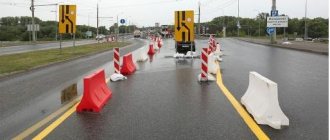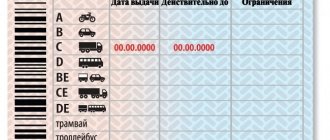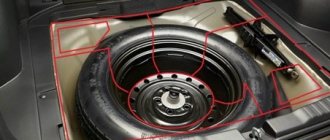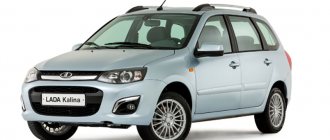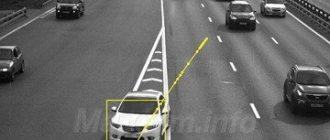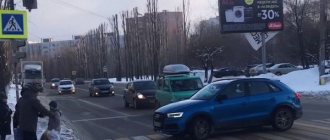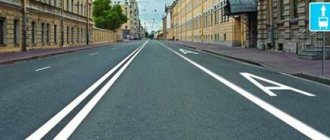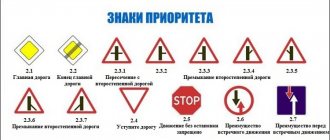The first white stripes at intersections and pedestrian crossings appeared in 1918 in the UK, in the suburbs of Birmingham, and dividing stripes appeared even earlier, in 1911 in the USA. Today you won’t surprise anyone with road markings. It has long been standardized throughout the world, and special requirements are imposed on application materials.
The first road markings appeared in the USA and Great Britain
Markup requirements
Today, the law strictly regulates what type, size and configuration road markings should be. The requirements are specified in GOST R 51256-2018 “Technical means of organizing road traffic. Road markings..." from 2020.
Permanent horizontal markings can be white, yellow, red, blue, black and green, and temporary ones can be orange. It is applied with paints (enamels), cold and thermoplastics, polymer tapes and piece forms, which have certificates and meet the requirements of GOSTs. Vertical (on pillars, parapets, fence supports) - can be white or black, applied with special paints or reflective materials.
The first zebra in the form to which we are accustomed appeared in Great Britain on October 31, 1951. Previously, a section of the road for safe crossing of pedestrians was marked by placing metal circles on the asphalt. In Germany, these markings are so valued that they celebrate the zebra's birthday every year.
Horizontal marking
According to traffic regulations, markings on the road can be not only in the form of lines, but also arrows, inscriptions and other images. Each type has its own meaning: it determines the order of movement of drivers and carries other information for traffic participants.
The horizontal type of marking can be permanent or temporary. The first type includes all white and yellow lines. But the orange tint indicates temporary markings.
View gallery
How often should road markings be updated?
GOST sets out the requirements for the thickness and brightness of markings. If the paint layer is less than 1.5 mm thick, in any control section 50 m long, the destruction of the material should not exceed 50%. In the case of thermoplastic with a thickness of more than 1.5 mm, destruction of up to 25% of the total area is allowed.
In practice, road markings applied with paint do not require updating for several months. On main city streets it wears out faster. In residential buildings, industrial and municipal warehouse areas it lasts for at least six months. According to GOST, the functional durability of horizontal markings is at least three months.
Road markings wear out not only on busy highways
Notes[ | ]
- Road markings, Great Soviet Encyclopedia
- History of road markings (unspecified)
(inaccessible link). Retrieved October 29, 2020. Archived October 24, 2014. - Test tasks on the topic of traffic rules for students
- In Russia, they changed the rules of roundabouts and introduced “waffle markings”
- Traffic rules are changing again. How to drive around now? What is “waffle marking”?
- Traffic rules (inaccessible link)
How to apply road markings
The surface is cleaned using special equipment or manually. If necessary, perform routine coating repairs, fill cracks, and inspect hatches. If the road is wet, it is dried. If plastic or polymer tapes are chosen, a primer is applied to cement concrete and old asphalt pavements to increase adhesion. Preliminary marking is being carried out.
Depending on the material, certain technology/equipment is used. The easiest way to work is with paint. One-component compositions are applied by pneumatic or hydraulic spraying. Multi-component - mix first. Stencils are used in the work. If there are none, the lines and symbols to be applied are limited with adhesive tape.
The work is carried out on a dry sunny day at an air temperature of at least +5 °C. In rainy or frosty weather, specialized equipment is needed to warm up and dry the road, as well as special marking material. The applied layer must dry within an hour before vehicles can drive on the road.
Using the “cold” method, paints, enamels, and cold plastics are applied to the road. “Hot” (at a melt temperature of 180–220 °C) – thermoplastics, spray plastics and thermoplastic tapes. You can work with them in the air temperature range of +5…+35 °C. The most convenient to apply and safe are paints and enamels that can last from one season to one year.
The best time to apply road markings is spring or autumn
Video
Road markings are applied differently in different countries. For example, in the USA, special equipment is used for this, and work is often performed in the dark:
Red markings on the road what the traffic rules mean and what the fine is 2020
In most cases, it comes in the usual white color. These markings divide the roadway into traffic lanes and mark the edges of the road. Depending on the situation, the line can be solid or broken.
The first one, as you know, cannot be crossed. Well, the most serious fines are issued when vehicle drivers make any maneuver through a double solid line.
White markings also mark pedestrian crossings and stop lines, including those in front of traffic lights.
Not so long ago in Russia, along with the traditional white road markings, new lines appeared on roads - yellow and orange.
Some drivers, especially those who had not been familiar with traffic rules updates for a long time, were simply baffled by them. Let's take a closer look at what the yellow and orange markings on the road mean.
Do not forget that ignorance of traffic rules is not only fines, but also a direct threat to other road users.
What do the red markings on the bicycle road before the bus stop mean?
If a minibus leaves the route, for example, to avoid a traffic jam, it loses the right not to follow these signs. We quote the Russian Federation Traffic Regulations: 3. Prohibition signs The signs do not apply: 3.1 - 3.3, 3.18.1, 3.
18.2, 3.19, 3.27 - for route vehicles; Here we are talking about the following road signs: 4. Mandatory signs The validity of signs 4.1.1 - 4.1.6 does not apply to route vehicles.
In the coverage area of marking 1.17 in combination with the signs “Bus and (or) trolleybus stopping place” (5.16) and “Tram stopping place” (5.17), it is prohibited: firstly, to make a U-turn and reverse; secondly, to stopping and parking of vehicles (as well as at a distance of 15 meters before and after the marking site).
What do yellow markings on the road mean according to traffic rules?
Zigzag markings are applied at the edge of the roadway, as well as in the middle of the road if we are talking about a tram. Depending on its length, one or more vehicles will be able to stop at the same time. Failure to comply with the rules established in connection with the broken line will subject the driver to penalties.
https://www.youtube.com/watch?v=TbUhBmEOovw
On the territory of the Russian Federation, yellow markings in the center of the road can be applied using any materials that meet the established requirements: paint, thermoplastic, polymer tape that does not protrude more than 6 mm above the road surface. GOST sets the coefficient of adhesion to the surface (25%), as well as the durability of the coloring material (from 6 months).
Red road markings
Red horizontal road markings do exist. This color is used to indicate temporary markings in Austria and Switzerland. It means repair work or the need for temporary reorganization of traffic. It is acceptable to use red markings on the territory of Ukraine.
One of the points of the resolution of the Cabinet of Ministers of Ukraine dated February 11, 2013 No. 111 “On amendments to the Traffic Rules” was the introduction of a new type of graphic designation - 1.15. A horizontal red stripe with white dash-dot lines indicates where the bicycle path crosses the roadway.
Red color is also used to highlight pedestrian crossings. In places where there are frequent collisions with pedestrians, the usual zebra lines are supplemented with red inserts, which make the crossing area more visible. This innovation is especially relevant in the winter season. The use of red in marking 2.3 has the same purpose.
This vertical marking is used to paint shields under signs 4.7-4.9.
If the requirements are not met, the driver will face a fine. You can challenge the decision of the traffic police officer using photos or video recording.
You can only refer to the poor visibility of the markings on the road (pollution, wear).
You will not be able to use color mismatch as an argument if the markings were applied with certified materials in accordance with GOST R 52289-2004 and GOST R 51256-99.
What do red markings on the road mean?
Therefore, if you are caught under Article 12.15.4, it is best to agree with the traffic police officer and give him your license. And then, during the analysis, “repent” to the inspector. In extreme cases, you will be sent to court.
But unlike traffic police officers, judges are more loyal to those who plead guilty and impose the minimum punishment - a fine. But if you are firmly convinced that the rules were not violated, and the protocol was drawn up unfairly, start the “war” from the very first minutes.
In the protocol, in the column “Explanations of the violator,” write: “Did not violate traffic rules, qualified legal assistance is required.” Next, make a complaint (either with the help of a lawyer or on an online forum) and register it with the traffic police department.
A response to a complaint is required to be given within 10 days, but in reality it takes up to a month. But the court has only two months from the date of violation to deprive you of your rights. And then there is a high chance that the case simply will not be considered on time.
Pavel (Jaja) Yuri Kornilov, you are a little wrong. if the protocol is drawn up according to Part 4 of Article 12.15, then it does not go to any analysis group - the material is immediately sent to the court. in court - imprisonment for 4-6 months. for part 3 of the same article - a fine of 1000-1500 is imposed by the unit commander (or a judge, if part 4 is reclassified to 3 in court)
What are the markings on the road according to traffic regulations?
More attention should be paid to the drawing itself. If it is solid red, you are not allowed to cross it. Traffic participants also have nothing to do with the median marking, because it divides the road into sections intended for different directions. Road services can use red paint in the absence of orange.
- 1.1 limits lanes intended for traffic in opposite directions. Naturally, you can’t cross it; this will be driving into the oncoming traffic.
- 1.2 is applied to mark the boundary of the roadway. Driving outside of it is prohibited. It is also forbidden to drag the wheels while driving. But according to traffic regulations, a solid marking line at the edge of the road can be crossed to stop a vehicle. The same is permitted when leaving the roadside to continue driving.
- 1.3 are never crossed. A double solid line demarcates the flow of oncoming traffic on a multi-lane road.
- 1.4 means it is prohibited to stop at this place. It is painted in yellow.
- 1.11 consists of a dotted line and a solid line, running close and parallel. Applied to separate traffic lanes. You can cross it from the side of the broken line. And from a solid one - only when overtaking or bypassing an obstacle is completed.
- 1.12. It is allowed to cross it. But only after stopping in front of this lane.
We recommend reading: Okof for Monoblock in 2020
STOP sign or driving without stopping is prohibited
According to traffic regulations, a red sign is installed near unregulated intersections, i.e. those without traffic lights.
These are places where main and secondary roads intersect, T-shaped intersections, areas where visibility is limited for the driver.
Usually the “STOP” sign is accompanied by a special marking - a stop line. Drivers must comply with the following rules:
A “STOP” sign on a white background is installed near unregulated and controlled pedestrian crossings or traffic lights and unregulated railway crossings. The symbol informs that the motorist may not stop in this place, except when there is a pedestrian at the crossing or the traffic light is prohibited.
What do red markings on the road mean?
Yury (Saveria) Driving into the oncoming lane The traffic rules describe four cases prohibiting driving into the oncoming lane: Yury (Saveria) Cases often arise when the markings on the road are erased or covered with snow. As a result, it turns out that the car crosses a double solid marking line.
Such a line informs the motorist about the edge of the roadway, and it is prohibited to cross it; ·The dotted stripe with similar intervals and strokes informs about the traffic lanes at the intersection; It is a line in which the strokes are 3 times the distance between the dotted lines. She informs that there is a continuous road nearby that divides the roadway into different traffic flows; · Stripe in the form of strokes.
Yellow marking line along the roadside and curb
- 1.4 - a solid line, which is mainly applied at a short distance (10-20 centimeters) from the curb or roadside. Its presence indicates that stopping in this area is prohibited. It may indicate the coverage area of sign 3.27. Thus, you cannot stop at the allocated interval, much less leave the car for longer than 5 minutes;
- 1.10 - dotted line. Warns the driver that parking is prohibited on the marked section of the roadway (in addition to or placed separately from sign 3.28);
- 1.17 - zigzag line. It is painted on the asphalt where route vehicles stop to transport passengers or taxis. According to traffic regulations, parking here is also prohibited.
- white - constant, with its help most of all symbols are applied - solid, dotted, dividing stripes, zebra, stop line, etc.;
- orange - temporary, if you see it, it means that road work is underway somewhere nearby and you need to be guided by the requirements of the orange lines;
- yellow is also a permanent one, it is used solely for the sake of convenience and good visibility, it is applied in most cases in the area of bus stops.
What do yellow road traffic markings mean?
What do yellow road markings mean? According to traffic regulations, yellow road markings 1.4, 1.10, 1.17.1, 1.17.2, 1.26 are also permanent. It’s not difficult to remember: there are only three types of yellow road markings, namely: a yellow solid line, a yellow broken line and, finally, a yellow zigzag line .
For those who are not in the know, the markings come not in two colors, as some believe, but in three colors: white, yellow and orange. In general, it can be said that such variety is used more for convenience than for any other purpose . So, the orange road markings are temporary.
Yellow curbs and shoulders, which means yellow markings on the road
The yellow zigzag stripe 1.17 along the edge of the road determines the stopping place for shuttle buses and taxis. Its length should not be less than the landing area itself, and is determined by the number of cars stopping or already standing at the same time.
What does the yellow stripe on the side of the road mean? It is applied along the edge of the roadway outside the city limits. In this case, crossing it, stopping or parking nearby will violate the restrictions imposed on traffic on the side of the road. Further, where the markings are interrupted, you can park the car.
08 Feb 2020 juristsib 585
Source: https://sibyurist.ru/vozniknovanie-prava-sobstvennosti/krasnaya-razmetka-na-doroge-chto-oboznachaet-pdd-kakoj-shtraf-2019
What do red markings on the roadway mean?
- as a temporary marking in the absence of orange paint. It must be duplicated by appropriate road signs. In this case, the driver must be guided by the temporary rules;
Dear readers! The article talks about typical ways to resolve legal issues, but each case is individual. If you want to find out how to solve your particular problem , contact a consultant:
What do yellow traffic markings mean?
1.19
- warns of approaching a narrowing of the roadway (a section where the number of lanes in a given direction is reduced) or marking lines 1.1 or 1.11 separating traffic flows in opposite directions. In the first case, marking 1.19 can be used in combination with signs 1.20.1-1.20.3;
Edward N. Hines (1870-1938), a member of the Wayne County Road Commission in the US state of Michigan, is considered the inventor of road markings. In 1911, he proposed putting a center line on the world's first concrete road, Woodward Avenue in Detroit, to separate lanes.
Road markings according to DD rules
This applies to cases where the markings are poorly visible - covered with snow or erased. This is stated in Government Decree No. 1090 of October 23, 1993. In particular, the information is contained in the Appendices to this Resolution.
- Marking material must be used exclusively for dismantling - that is, one that can be easily erased and washed off over time.
- The lines and their direction must comply with the standard of clause 2.5.2 of the Traffic Regulations, the purpose of fences.
- Permanent markings should not be removed.
- As soon as all the work is completed, temporary signs are removed from the canvas.
- If permanent markings were damaged during dismantling of temporary lines, then they must be restored to their original appearance.
This video is unavailable
What if the stop was forced? Stopping at an intersection due to sudden braking of the cars in front cannot serve as an excuse for a violation. “At the moment of entering the intersection, the driver must be sure that he will pass it without stopping and that exit from the intersection is free. If there is no such confidence, you cannot go to the intersection of roadways.”
What is considered a violation In order to receive a fine, the violator’s car will have to stand motionless on the waffle markings of the intersection for more than five seconds, the Moscow Traffic Police Department commented, but I think these rules will apply to all regions. The driver, in principle, should be guided by the concept that one can enter an intersection only if it can be passed without stopping.
We recommend reading: How to register a property share in the Rosreestre
Markings on the road, traffic rules: what does a red, orange, yellow, solid line mean, if not visible on the roadway, temporary, its types in the rules
Red color is also used to highlight pedestrian crossings. In places where there are frequent collisions with pedestrians, the usual zebra lines are supplemented with red inserts, which make the crossing area more visible. This innovation is especially relevant in the winter season. The use of red in marking 2.3 has the same purpose.
Markup 1.5
(a broken longitudinal line with intervals three times longer than the strokes) – separates traffic flows in opposite directions on roads with two or three lanes; indicates the boundaries of traffic lanes when there are two or more lanes intended for traffic in the same direction.
Penalty for hitting a solid marking line
In this case, he, of course, faces punishment. What fine can a motorist be given if he started overtaking on an intermittent line and ended up on a solid line?
But in order for the driver not to be fined or acquitted by the court, he must record the condition of the road markings in a photo or video. This is the only way he can prove the correctness of his actions on the road.
Red traffic markings on the road
This means that this type of marking may contradict permanent markings and even traffic signs. In this case, the driver must follow the temporary signs. If the requirements are not met, the driver will face a fine.
In Ukraine, the color red is also used in the markings that mark where bicycle paths cross the roadway: a large red line with small dashed white lines at the edges.
Yellow markings on the road: what does it mean?
- Crossing the yellow broken line along the side of the road falls under Article 12.15 Part 1 and is punishable by an administrative fine of 1,500 rubles. (for residents of the Moscow region - 3000 rubles).
- If you do not miss a fixed-route vehicle or a passenger taxi when leaving the zigzag line coverage area, you will be fined 500 rubles.
- Failure to comply with the prohibitions on stopping/parking within the broken line will result in a fine of RUB 1,000. The violator's vehicle is placed in the impound area.
- For making a U-turn and reversing in the area of a zigzag road, a fine of 500 rubles is provided.
According to the traffic rules (traffic rules), there are white, orange and yellow markings. It guides vehicle drivers and pedestrians on the roadway. Yellow was introduced relatively recently, and not everyone knows about its meaning.
The main types, requirements and administrative liability for violation of the rules will be discussed later in the article.
The real Dolinskaya truth
Marking number Image Explanation 1.1 Separates traffic flows in opposite directions and marks the boundaries of traffic lanes in dangerous places on the roads; indicates the boundaries of the roadway to which entry is prohibited; marks the boundaries of vehicle parking spaces.
Decree of the Government of the Russian Federation dated September 25, 2003 N 595 approves the yellow color for 1.17. The “crown” painted at the edge of the roadway means specially designated places for stopping taxis and fixed-route vehicles.
Source: https://pravitzakon.ru/nasledstvo/krasnaya-razmetka-na-doroge-chto-oboznachaet-pdd-kakoj-shtraf-2019
Why do road markings wear out quickly?
One of the reasons is non-compliance with application technology. The material peels off if the work was carried out at low temperatures, the surface was unprepared or wet, and it was not given time to dry.
Even if the markings were applied according to all the rules, after several months or after one or two years it still loses its performance. This is facilitated by heavy traffic, regular contact of strips with studded tires and snow removal equipment in the winter, chemicals, atmospheric conditions and low temperatures. The more turns and curves there are on the road, the faster the lines and signs on it will be erased.
Studded tires pose a particular danger to road markings
Horizontal markings
This type includes both longitudinal and transverse lines. This also includes arrows, various inscriptions and other symbols that are located on the roadway. It allows you to establish a certain required movement order and its modes. The following markings are shared:
- The center line on a highway with 2 or 3 lanes with cars moving in both directions separates the flow of cars from opposite directions. In addition, it can act as the boundaries of traffic lanes in unsafe places on the road, the boundaries of a roadway that is prohibited from entering, or the boundaries of a parking lot. It is prohibited to cross this line.
- A solid line always points the driver to the edge of the roadway. Also not crossed by a car.
- A line with strokes 2 times smaller than the spaces between these strokes usually indicates the edges of a roadway consisting of two lanes.
- A line whose strokes are three times larger than the spaces between dotted lines is called an approach line and warns of an imminent approach to a solid line, which divides the roadway into opposite traffic flows.
- A dotted line with equal strokes and spaces indicates the traffic lanes at the intersection.
- The wide broken line is the boundary between the braking or accelerating lane and the main lane. It can be found at road crossings, intersections, bus stops, etc.
- The stop line warns the driver that he must stop here immediately to comply with the requirements of the corresponding sign, traffic controller or traffic light.
- Probably the most famous is the " zebra crossing ", which indicates where pedestrians cross the roadway. The arrows on it correspond to the direction of movement of people.
What kind of paint is applied to roads?
For constant use on heavily trafficked highways, runways and airfields, you need paint that forms a wear-resistant coating.
The layer must be resistant to chemicals used in the fight against snow and ice, to bright light, be hard and impact-resistant. These requirements are met by the “Avtomagistralnaya” AK-511 road paint, which demonstrates high abrasion resistance due to the presence of acrylic copolymers and plasticizers in the composition.
The material forms a durable, bright coating of white or yellow colors. To improve visibility at night, reflective glass microbeads ranging in size from 70 to 300 microns are added to the freshly applied paint. The layer dries quickly - no longer than 30 minutes at an air temperature of +20 ° C. The paint is economical in consumption - 350–500 g/m2.
With the help of such glass chips, road markings become reflective
Recently the British expressed an interesting idea. They believe that if road markings are completely removed, traffic safety... will improve! In the absence of identification signs, drivers will drive slower (by about 13%) and will become more careful on the road. Perhaps someday this will happen. Today, in many countries, including Russia, they are in no hurry to abandon markings. This means that the priority is wear-resistant, durable materials, for example, convenient and practical paint.
Why were the changes introduced?
The use of yellow color when marking is practiced in many countries around the world. It has been proven that the human eye perceives this shade better than white. This becomes especially true if it is raining outside and there is thick fog. When visibility is poor, the white color blends in with the snow cover and ice. Yellow is not. Based on this, the Ministry of Transport officially recommended that road organizations use it. According to the creators of GOST 51256-2018, the new type of lines should perform the same function as white intermittent markings. Yellow color is planned to be used in those regions where cloudy weather is often observed and there is a lot of precipitation.
One question remains: if changes have not yet been made to the Traffic Rules, is it necessary to follow what the yellow intermittent markings prescribe? Yes need. At the same time, we also must not forget about the signs.
By the way, the yellow center line can be solid (marking 1.1). Overtaking through it, as well as through the white one, is strictly prohibited. Some believe that since the traffic rules do not mention this type of marking, this can be appealed in court. Such reasoning is naive and may result in the deprivation of your driver's license. Moreover, the yellow color is precisely used so that the motorist can see the ban in any weather conditions. Therefore, it’s still not worth playing with fire. And adjusting the text of the Road Traffic Rules is most likely a matter of the near future.
zen.yandex.ru
